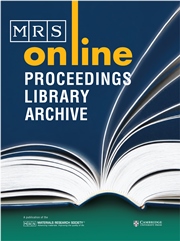Article contents
Comparison and Modeling of Aqueous Dissolution Rates of VariousUranium Oxides
Published online by Cambridge University Press: 03 September 2012
Abstract
The purpose of this work has been to measure and model the intrinsicdissolution rates of uranium oxides under a variety of well-controlledconditions that are relevant to a geologic repository. When exposed to airat elevated temperature, spent fuel may form the stable phase U3O8. Dehydrated schoepite, UO3H2O, has been shown to exist in drip tests onspent fuel.
Equivalent sets of U3O8 and UO3H2 dissolution experiments allowed a systematicexamination of the effects of temperature (25–75°C), pH (8–10) and carbonate (2–200×10−4 molar) concentrations at atmospheric oxygenconditions.
Results indicate that UO3H2O has a much higherdissolution rate (at least ten-fold) than U3O8 underthe same conditions. The intrinsic dissolution rate of unirradiated U3O8 is about twice that of UO2.Dissolution of both U3O8 and UO3.H2O shows a very high sensitivity to carbonateconcentration. Present results show a 25 to 50-fold increase inroom-temperature UO3H2O dissolution rates between thehighest and lowest carbonate concentrations.
As with the UO2 dissolution data the classical observed chemicalkinetic rate law was used to model the U3O8dissolution rate data. The pH did not have much effect on the models, inagreement with the earlier analysis of the UO2 and spent fueldissolution data,. However, carbonate concentration, not temperature, hadthe strongest effect on the U3O8 dissolution rate. The U3O8 dissolution activation energy was about 6000cal/mol, compared with 7300 and 8000 cal/mol for spent fuel and UO2 respectively.
Information
- Type
- Research Article
- Information
- Copyright
- Copyright © Materials Research Society 1997
References
REFERENCES
- 10
- Cited by

